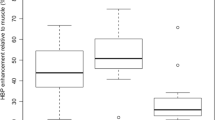Abstract
Purpose
The purpose of this study was to report the imaging presentation of hepatic metastases from hepatoid adenocarcinoma (HAC).
Methods
We retrospectively identified 11 patients (10 men and 1 woman; median age 66) with HAC liver metastasis who underwent contrast-enhanced computed tomography (CT) which included arterial phase and portal venous phase. Two radiologists analyzed the imaging parameters, which included the enhancement pattern on arterial and portal phase images, necrosis, venous thrombi, and overall imaging diagnosis, and arrived at a consensus.
Results
On arterial phase, the liver lesions had global hyper-enhancement (n = 0), heterogeneous hyper-enhancement (63.6%; n = 7/11), peripheral hyper-enhancement (n = 0), iso-enhancement (n = 0/11), or hypo-enhancement (36.4%; n = 4/11). On portal venous phase, homogenous hypo-enhancement (18.2%; n = 2/11) and heterogenous hypo-enhancement (81.8%; n = 9/11) were observed. Venous thromboses occurred in four patients (36.4%; n = 4/11). The overall imaging diagnoses were “HCC-like” in seven patients (63.6%; n = 7/11), “indeterminable” in 1 patient (9.1%; n = 1/11), and “HCC-unlike” in three patients (27.3%; n = 3/11).
Conclusions
The imaging features of HAC liver metastasis were varied. Arterial phase enhancement coupled with venous phase washout (resembling HCC imaging features) was a major finding, but arterial phase hypo-enhancement (distinct from HCC imaging features) was also frequently encountered.




Similar content being viewed by others
References
Ye MF, Tao F, Liu F, Sun AJ (2013) Hepatoid adenocarcinoma of the stomach: a report of three cases. World J Gastroenterol 19(27):4437–4442. doi:10.3748/wjg.v19.i27.4437
Su JS, Chen YT, Wang RC, et al. (2013) Clinicopathological characteristics in the differential diagnosis of hepatoid adenocarcinoma: a literature review. World J Gastroenterol 19(3):321–327. doi:10.3748/wjg.v19.i3.321
Ishikura H, Kanda M, Ito M, Nosaka K, Mizuno K (1990) Hepatoid adenocarcinoma: a distinctive histological subtype of alpha-fetoprotein-producing lung carcinoma. Virchows Archiv A 417(1):73–80. doi:10.1007/bf01600112
Hocking GR, Shembrey M, Hay D, Östör AG (1995) Alpha-fetoprotein-producing adenocarcinoma of the sigmoid colon with possible hepatoid differentiation. Pathology 27(3):277–279. doi:10.1080/00313029500169113
Chang YC, Nagasue N, Abe S, et al. (1991) alpha Fetoprotein producing early gastric cancer with liver metastasis: report of three cases. Gut 32(5):542–545
Nagai E, Ueyama T, Yao T, Tsuneyoshi M (1993) Hepatoid adenocarcinoma of the stomach. A clinicopathologic and immunohistochemical analysis. Cancer 72(6):1827–1835
Ishikura H, Kishimoto T, Andachi H, Kakuta Y, Yoshiki T (1997) Gastrointestinal hepatoid adenocarcinoma: venous permeation and mimicry of hepatocellular carcinoma, a report of four cases. Histopathology 31(1):47–54
Uefuji K, Ichikura T, Tamakuma S (1994) Roles of histological findings and serum AFP levels in the prognosis of AFP-producing gastric cancers. Jpn J Clin Oncol 24(3):135–140
Liu X, Cheng Y, Sheng W, et al. (2010) Analysis of clinicopathologic features and prognostic factors in hepatoid adenocarcinoma of the stomach. Am J Surg Pathol 34(10):1465–1471. doi:10.1097/PAS.0b013e3181f0a873
Terracciano LM, Glatz K, Mhawech P, et al. (2003) Hepatoid adenocarcinoma with liver metastasis mimicking hepatocellular carcinoma: an immunohistochemical and molecular study of eight cases. Am J Surg Pathol 27(10):1302–1312
Lin YY, Chen CM, Huang YH, et al. (2015) Liver metastasis from hepatoid adenocarcinoma of the stomach mimicking hepatocellular carcinoma: dynamic computed tomography findings. World J Gastroenterol 21(48):13524–13531. doi:10.3748/wjg.v21.i48.13524
Moon JY, Kim GH, Cheong JH, et al. (2012) A case of hepatic metastasis of gastric hepatoid adenocarcinoma mistaken for primary hepatocellular carcinoma. Korean J Gastroenterol 60(4):262–266
Jo JM, Kim JW, Heo SH, et al. (2012) Hepatic metastases from hepatoid adenocarcinoma of stomach mimicking hepatocellular carcinoma. Clin Mol Hepatol 18(4):420–423. doi:10.3350/cmh.2012.18.4.420
Lin CW, Hsu CC, Chang HC, et al. (2009) Hepatoid adenocarcinoma of the stomach with liver metastasis mimicking hepatocellular carcinoma: a case report. Cases J 2:6317. doi:10.4076/1757-1626-2-6317
Kashani A, Ellis JC, Kahn M, Jamil LH (2015) Liver metastasis from hepatoid adenocarcinoma of the esophagus mimicking hepatocellular carcinoma. Gastroenterol Rep (Oxf). doi:10.1093/gastro/gov021
Bazeries P, Barral M, Labrife M, Soyer P, Aube C (2016) Hepatic metastases from gastric hepatoid adenocarcinoma: an unusual cause of capsular retraction of the liver. Diagn Interv Imaging 97(9):931–934. doi:10.1016/j.diii.2016.06.001
Sheng RF, Xie YH, Ji Y, et al. (2016) MR comparative study of combined hepatocellular-cholangiocarcinoma in normal, fibrotic, and cirrhotic livers. Abdom Radiol (NY). doi:10.1007/s00261-016-0811-y
de Campos RO, Semelka RC, Azevedo RM, et al. (2012) Combined hepatocellular carcinoma-cholangiocarcinoma: report of MR appearance in eleven patients. J Magn Reson Imaging 36(5):1139–1147. doi:10.1002/jmri.23754
Choi JY, Lee JM, Sirlin CB (2014) CT and MR imaging diagnosis and staging of hepatocellular carcinoma: part II. Extracellular agents, hepatobiliary agents, and ancillary imaging features. Radiology 273(1):30–50. doi:10.1148/radiol.14132362
Sica GT, Ji H, Ros PR (2000) CT and MR Imaging of Hepatic Metastases. AJR Am J Roentgenol 174(3):691–698. doi:10.2214/ajr.174.3.1740691
Bosman FT, Carneiro F, Hruban RH, Theise ND (2010) WHO classification of tumours of the digestive system, 4th edn. Geneva: World Health Organization
Gálvez-Muñoz E, Gallego-Plazas J, Gonzalez-Orozco V, et al. (2009) Hepatoid adenocarcinoma of the stomach–a different histology for not so different gastric adenocarcinoma: a case report. Int Sem Surg Oncol 6(1):1–6. doi:10.1186/1477-7800-6-13
Zizi-Sermpetzoglou A, Moustou E, Tsavari A, et al. (2013) Gastric hepatoid adenocarcinoma. Hellenic J Surg 85(5):355–359. doi:10.1007/s13126-013-0065-x
Lin CY, Yeh HC, Hsu CM, Lin WR, Chiu CT (2015) Clinicopathologial features of gastric hepatoid adenocarcinoma. Biomed J 38(1):65–69. doi:10.4103/2319-4170.126860
Author information
Authors and Affiliations
Corresponding author
Ethics declarations
Funding
No funding was received for this study.
Conflict of interest
The authors declare that they have no conflict of interest.
Ethical approval
All procedures performed in studies involving human participants were in accordance with the ethical standards of the institutional and/or national research committee and with the 1964 Helsinki declaration and its later amendments or comparable ethical standards.
Informed consent
A waiver of informed consent was obtained from the institutional review board as this was a retrospective study and all patients underwent CT as part of their clinical work-up.
Rights and permissions
About this article
Cite this article
Chang, MY., Kim, H.J., Park, S.H. et al. CT features of hepatic metastases from hepatoid adenocarcinoma. Abdom Radiol 42, 2402–2409 (2017). https://doi.org/10.1007/s00261-017-1150-3
Published:
Issue Date:
DOI: https://doi.org/10.1007/s00261-017-1150-3




